A plant-collector’s jungle garden of palms, sotol, and more
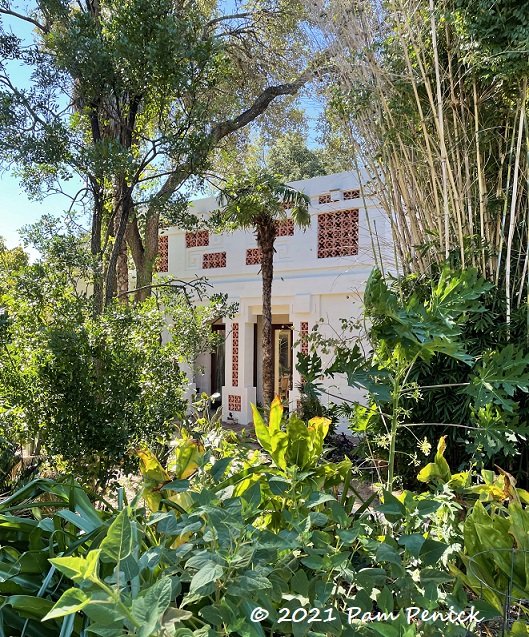
Like a Mayan ruin — except not crumbling and with a fresh coat of white paint — John Ignacio’s house near Bull Creek in northwest Austin stands amid a jungle-evoking garden of palms, bamboo, and other bold foliage. I’d been introduced to John by a mutual friend, and after a year’s delay thanks to covid and the Freezepocalypse, I finally arrived at his garden — only 11 minutes but a world away from my own — with Loree Bohl of Danger Garden during her October visit.
John had warned me that his garden was pummeled by the February freeze, and some of his plants were still in recovery, like bamboos growing back from the roots and palms that were newly re-leafed. I know he worked nonstop this spring and summer to remove cold-blasted plants, as we all did. But even so, I thought his garden, which probably pushes our 8b hardiness zone more than most, looked remarkably lush and full.
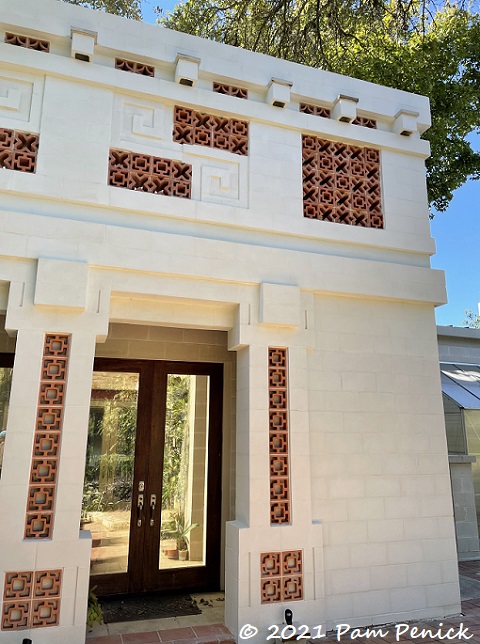
And that house! The white block home with terracotta breezeblock and rectangular scroll designs stands out among its 1970s-ranch neighbors. Inspired by Mayan ruins in Uxmal, Tulum, and Chichen Itza, John designed it himself and then had an architect draw up blueprints.
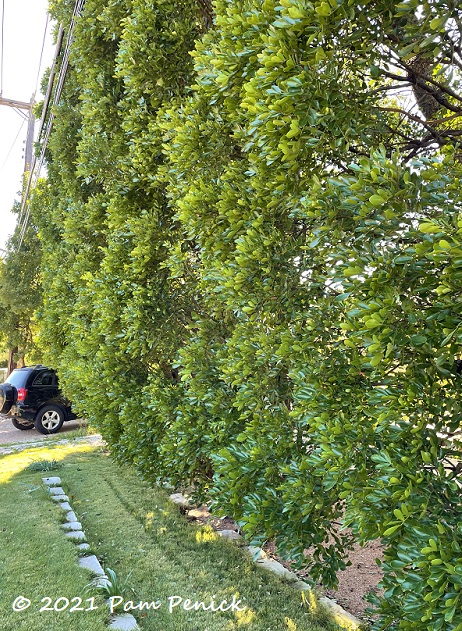
Dense plantings along the street and in the front yard soften that Mayan surprise, allowing a slow reveal as you enter the jungly world that John has created. A tall clipped hedge of Texas mountain laurel (Sophora secundiflora) makes a green screen along one side.
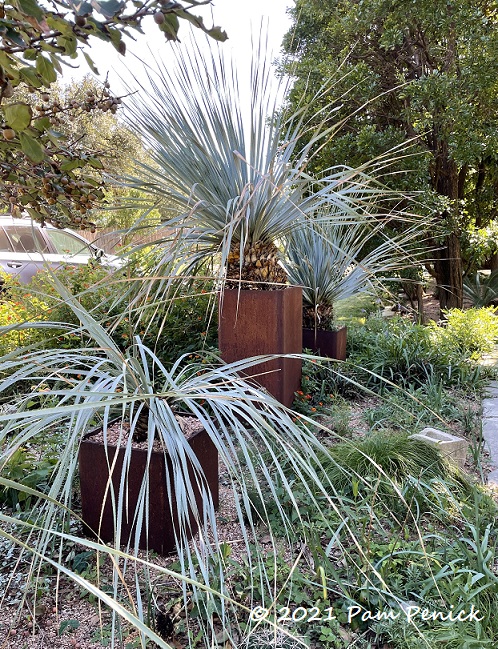
And a line of pruned-up, powder-blue Dasylirion berlandieri in square steel pipes screens the sunnier side of the front yard. Shazam!
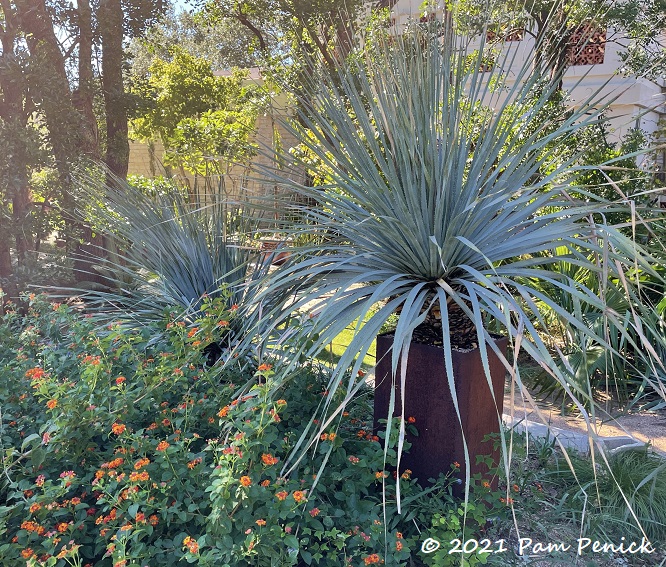
Lantana tumbles around them as seen from the street side. More on these later.
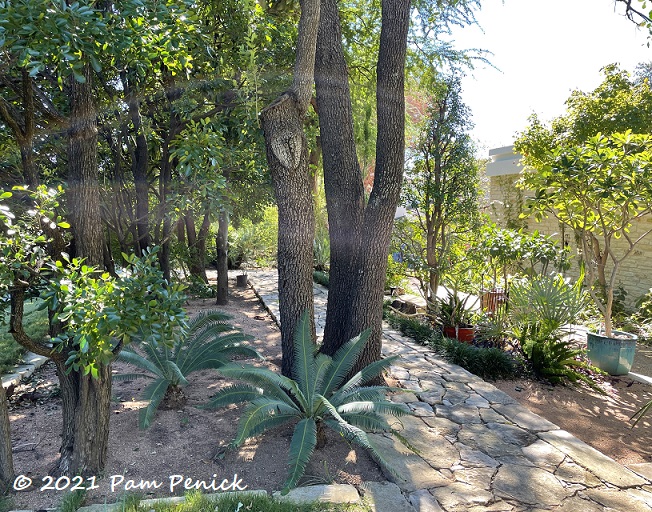
First let’s explore the shadier side, which you enter from the driveway. A straight path of fitted-together limestone leads through the garden lengthwise, parallel to the house. I’ve never seen such tall Texas mountain laurels as those hedged up along the street. Under their lifted canopy, feathery dioons enjoy the dappled shade.
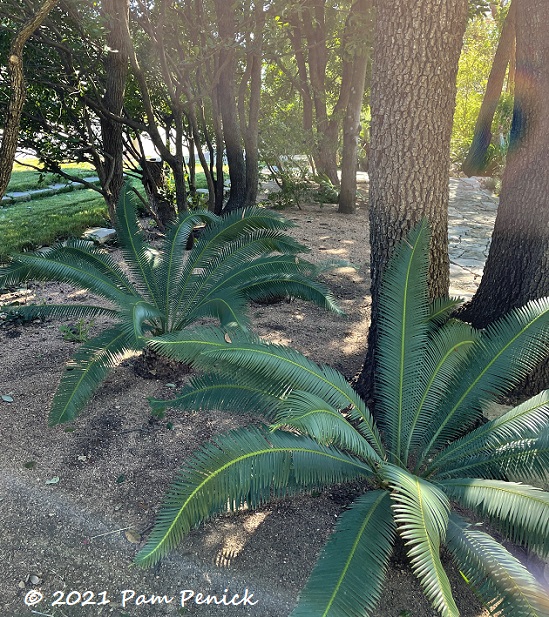
Dioon edule or angustifolium — John isn’t sure how to tell the two apart, and I don’t know either. They’re beautiful, aren’t they? I prefer dioon, with its relaxed, feathery appearance, to its stiffer, spikier cousin, the sago palm. Unfortunately I managed to kill the dioon I splurged on a few years ago.
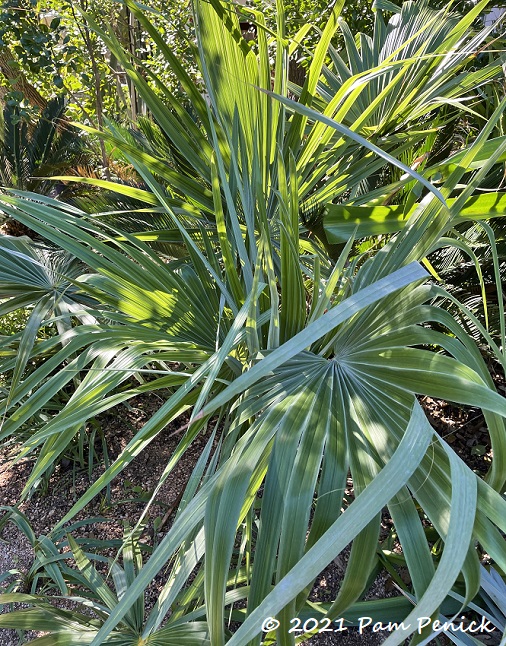
Dwarf rock palm (Brahea moorei) — rare yet quite hardy, according to John — also enjoying dappled sunlight.
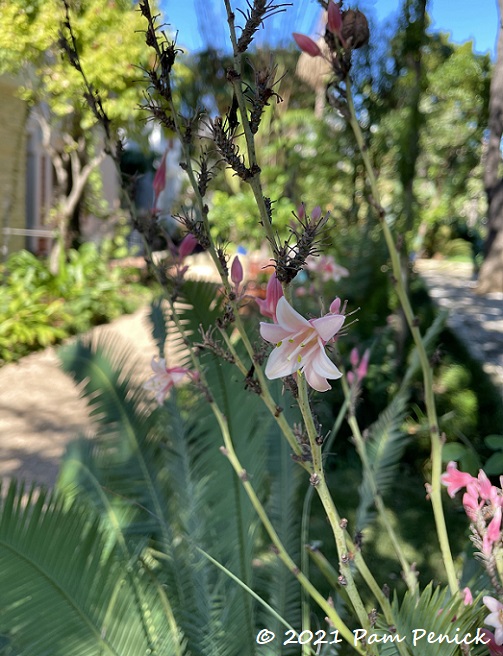
A pink hesperaloe flowering along the stone path
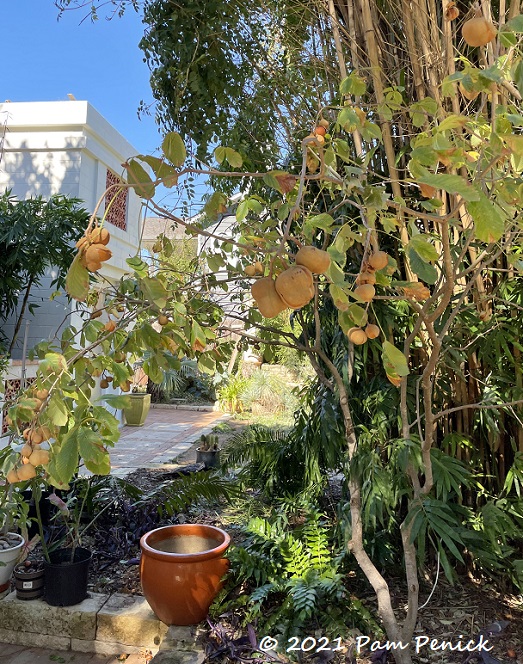
Next to a skyscraping clump of bamboo, still in recovery after the big freeze, scarlet buckeye (Aesculus pavia var. pavia) was stealing the show with clusters of pitted, tan fruit pods.
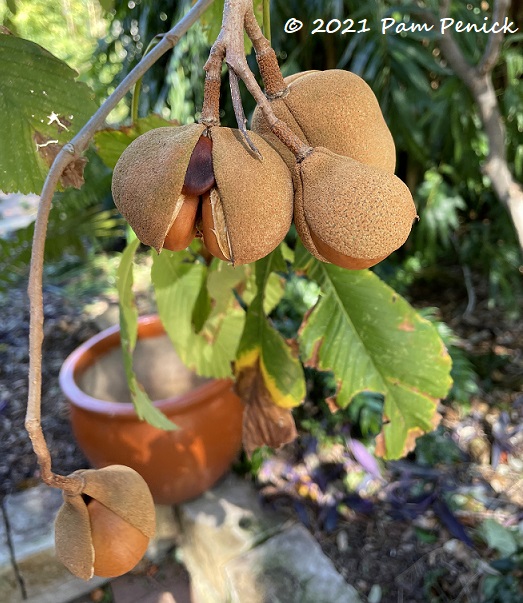
Scarlet buckeye is native throughout the South and Lower Midwest, ranging as far west as Central Texas.
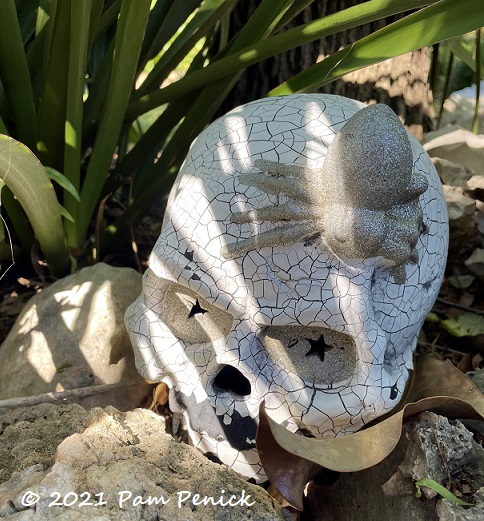
A little Halloween moment during our visit in late October.
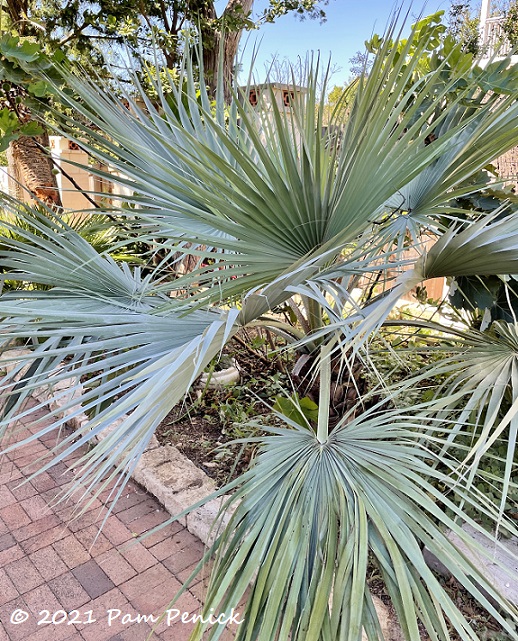
John grows many species of palm, including this beauty, Mexican blue palm (Brahea armata), which he describes as “the bluest and most underrated palm for Austin. Hardier than so many others. Cannot stand any shade. Give it full sun and it’s a winner!”
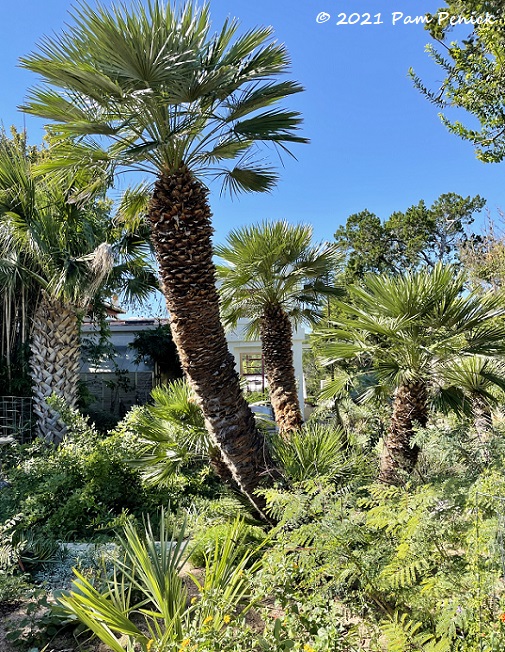
When he told me this giant is a multi-trunked Mediterranean fan palm (Chamaerops humilis), I was shocked. I have one of these slow-growing palms in my own garden, and I thought it would eventually top out around 10 feet. Now I’m giving it serious side-eye. (The white-trunked palm at back-left is Sabal mexicana, native to South Texas.)
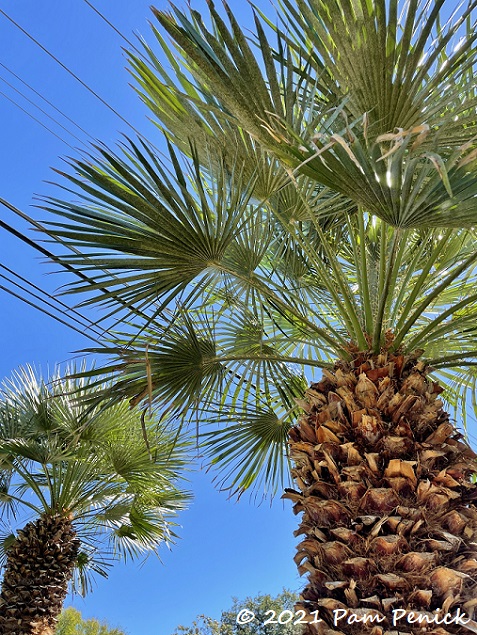
John planted his Mediterranean fan palm in 1995. “I have to trim the hell out of it every year,” he says of this beast. “All the fronds were frozen off [in the February storm], and it’s already fully recovered.”
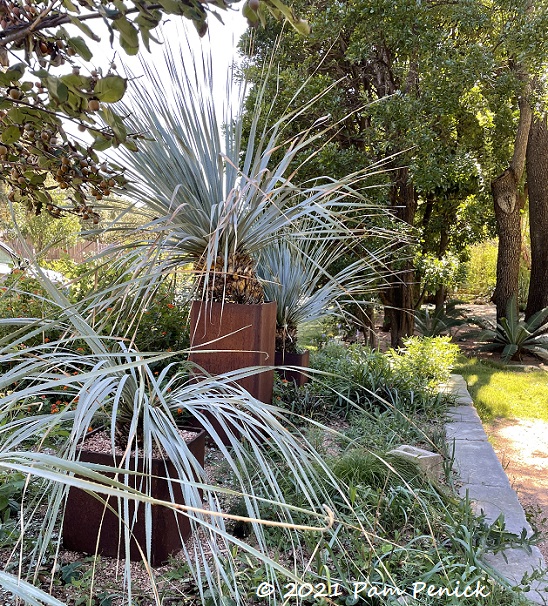
Let’s take another admiring look at the steel-pipe-planted Dasylirion berlandieri along the street. I love those rusty, chunky pipes staggered at different heights, with long, strappy, blue leaves spilling out of them.
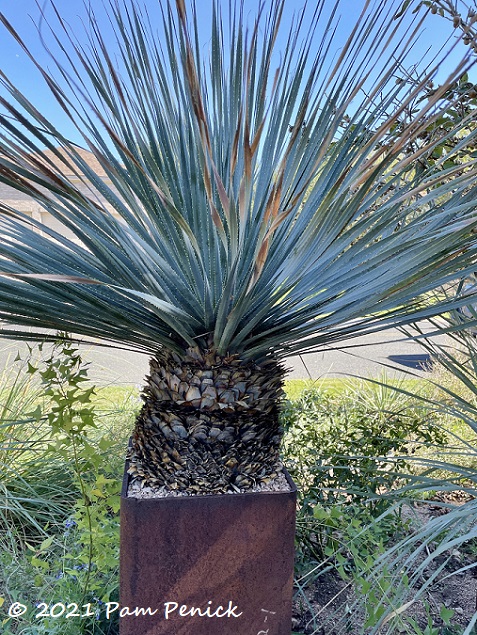
I forgot to ask John how long these have been growing here, but look at the size of that pruned-up trunk. Update: John says he collected the seed for these sotols with John Fairey in 1998 and planted them as soon as he got home, so they’re about 23 years old.
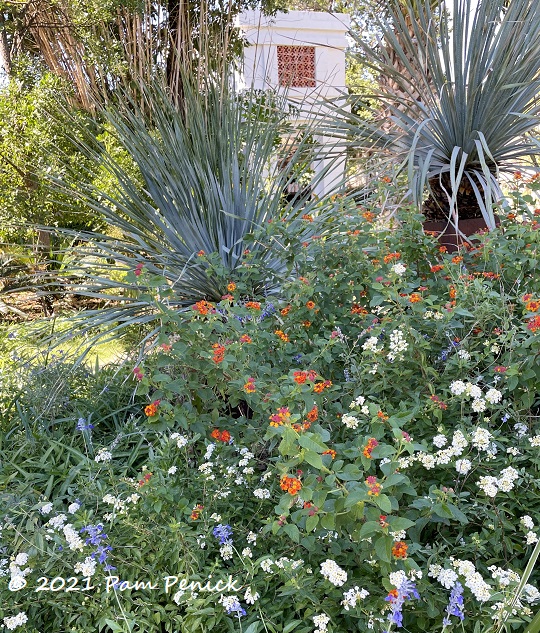
A medley of lantana and salvia, with the blue twister sotol — I think that’s its common name — rising up behind it.
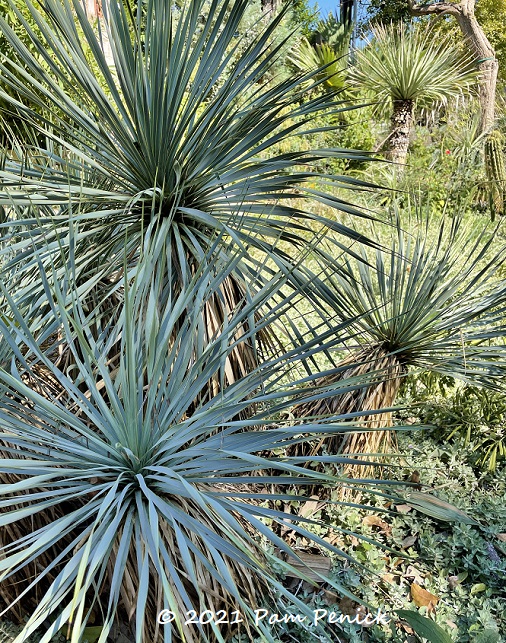
John has strappy blue yuccas too. This may be Yucca thompsoniana, “like a smaller Yucca rostrata,” he says.
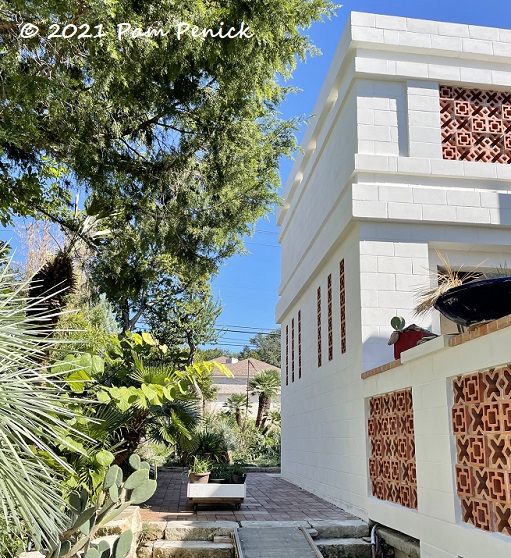
As John led us around to the back garden, I enjoyed the additional views of his unique house.
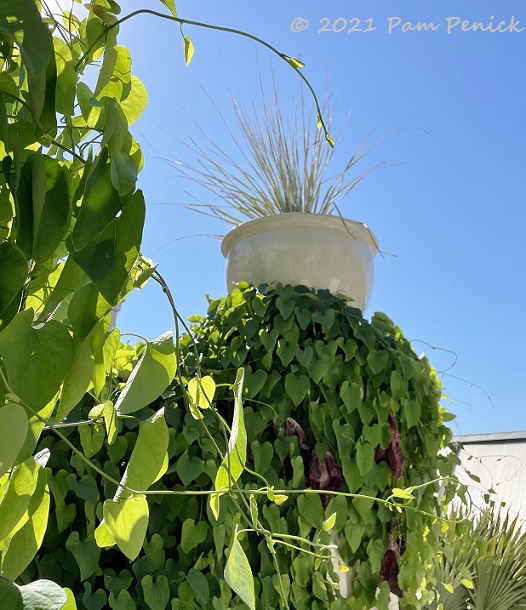
Clambering up a tall pillar on an upper terrace, an unusual vine caught my eye.
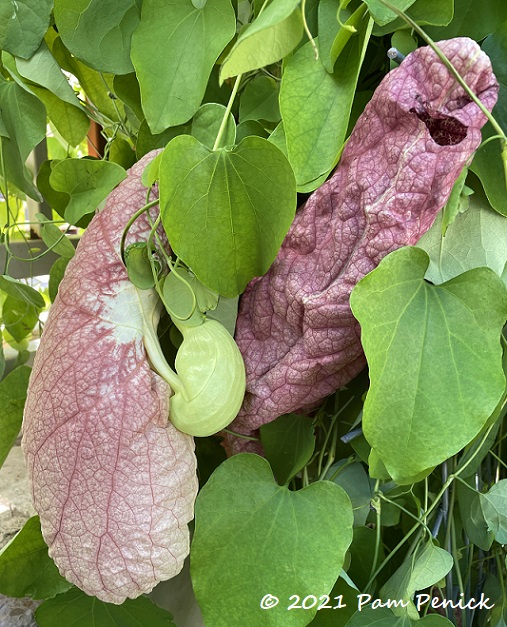
It’s Brazilian Dutchman’s pipe (Aristolochia gigantea), a Central/South American annual here in Austin. I’d seen it once before in designer Dustin Gimbel’s garden in Long Beach, California. The bladder-like flowers are kidney-shaped before they open.
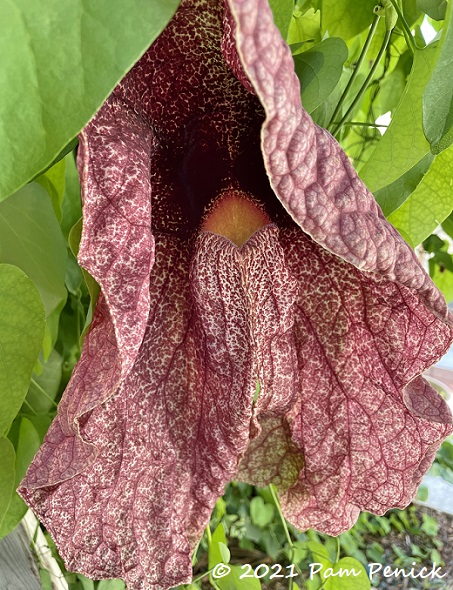
When open they resemble, well, a private part of the female anatomy. Or a mottled, upside-down heart, to be daintier.
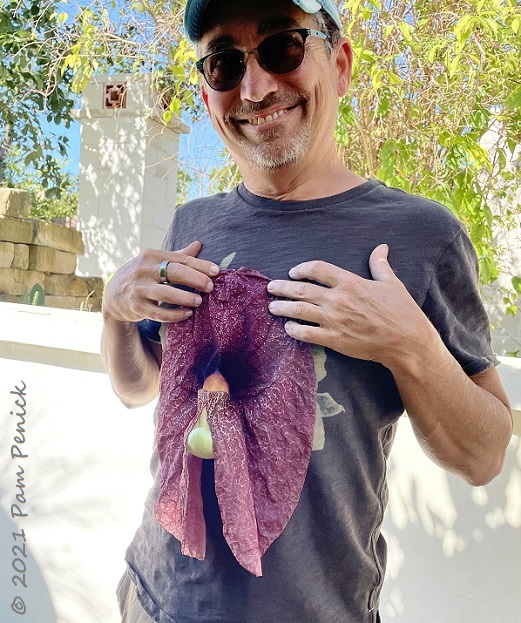
It’s an attention-getting plant for sure. John holds up one of the enormous flowers for scale.
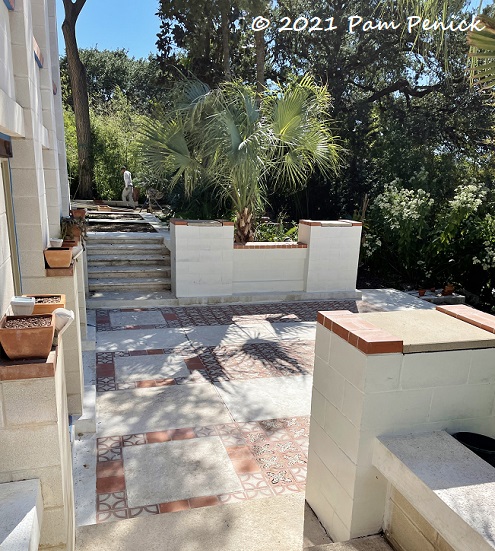
A long terrace extends off the rear of the house, with planter boxes displaying more fringe-leaved palms.
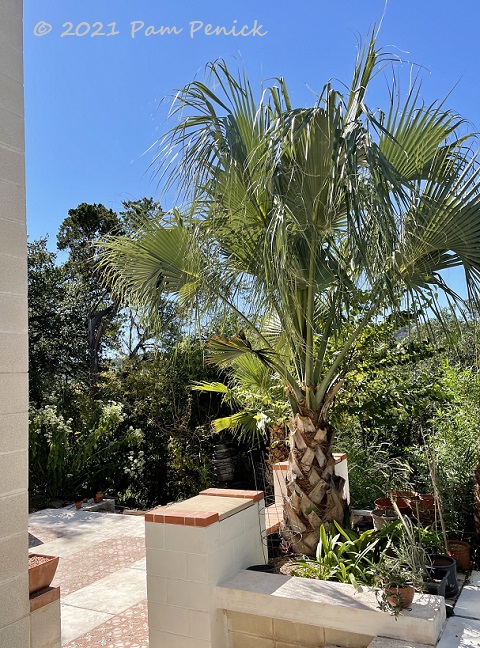
John describes his twin Sonoran palmettos (Sabal uresana) as “the most magnificent sabal we can grow here. These were massive. They froze completely [in the February freeze], and I pulled the rotted spear out of the center. This is all regrowth.” So it appears they are surprisingly hardy too!
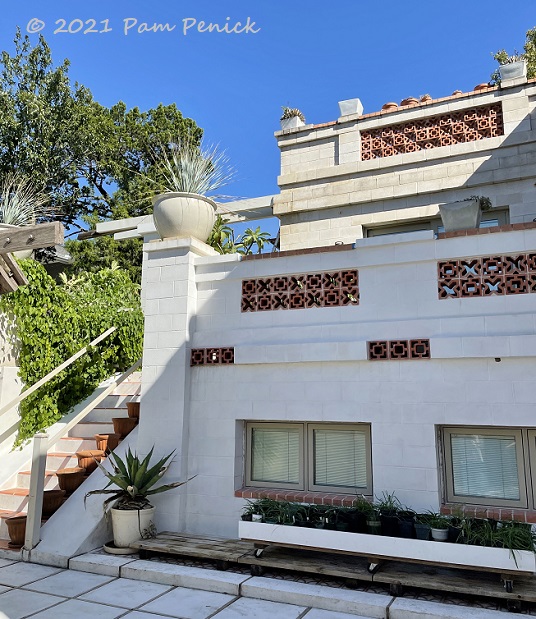
The upper terrace overlooks a large greenhouse (just out of frame) and the back garden, which slopes steeply downhill from the house.
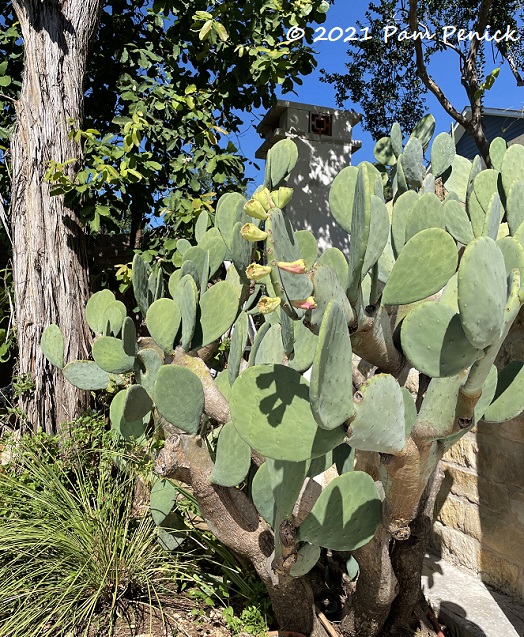
The lower hillside is more naturalistic, with shaggy juniper trees and healthy clumps of spineless prickly pear.
John’s garden is a collector’s wonderland of rare plants, and he’s generous with his extensive knowledge — and even gave us seeds of a rare sotol and palm harvested from his garden. His steel-pipe planters along the street inspired me to add a few more in my own garden, which I’ll show you in an upcoming post.
Thanks, John, for sharing your garden with us! Click here for Danger Garden’s take on John’s garden.
__________________________
Digging Deeper
Need design help with your yard? Hire me as your personal garden coach! Maybe you need replacement plant ideas after the big freeze. Or maybe your landscaping has grown tired, and you want fresh curb appeal. Or perhaps you’re ready to get rid of some lawn and create a pollinator garden, bird habitat, or hangout space for you and your friends. I’m here to help! Contact me to let me know what’s going on, and let’s figure it out together. My range is Austin and suburbs within a 25-min. drive of NW Austin, but I’m flexible and can travel farther with a surcharge, so let me know where you are. Weekday morning appts. only.
Come learn about gardening and design at Garden Spark! I organize in-person talks by inspiring designers, landscape architects, authors, and gardeners a few times a year in Austin. These are limited-attendance events that sell out quickly, so join the Garden Spark email list to be notified in advance; simply click this link and ask to be added. Season 8 kicks off in fall 2024. Stay tuned for more info!
All material © 2025 by Pam Penick for Digging. Unauthorized reproduction prohibited.


Nice to get another look at this house and garden after Loree’s post. You too made a great team covering it.
Thanks, Kris. And yet I think both Loree and I felt that we missed so much with our cameras. There was a lot to take in!
Wonderful post on John’s amazing jungle. I think I could visit every day for a week and still not see it all.
He’s got a lot going on!
Fabulous garden. The picture of John reminds me of the comedian Jon Richardson (British).
I don’t know that comedian, but I’m glad you enjoyed the garden!
Fabulous house, which you captured well. My Dioon edule dwindled away over several years. Don’t know why. My Sabal mexicana lost all its leaves in February and is growing them back. My Sabal uresana, which is still small, didn’t even notice the February event and is growing, albeit extremely slowly. I think the February event was even more severe here in central Dallas than it was in Austin.
It’s interesting, if disappointing, to hear that your dioon dwindled. That’s what happened to mine too. In fact it never thrived from day one. I wonder what the secret is.
Wow, I am floored by this house and garden. What a place! He has obviously shown his plants a lot of love over the years, and must have an amazing amount of knowledge on plants that will do well in Austin, despite not being readily available at nurseries. And the flowers on that Brazilian Dutchman’s pipe vine-I love them!! It was great to see posts by both you and Loree. I’m sorry I was out of town for her Garden Spark talk; it would have been so fun to hear her speak.
John really does have a tremendous amount of knowledge of so many unusual plants. And I was impressed to hear he went plant exploring with John Fairey too.
I saw Loree’s post a few weeks ago, and I continue to be amazed by what John has created. The house! The garden! This is a a serious contender for my favorite garden of the year!
The differences between Dioon edule and angustifolium are subtle, but angustifolium has narrower leaflets. More differences here: https://cycadales.eu/2021/02/16/differencesn-between-dioon-edule-and-dioon-angustifolium/?lang=en
Thanks for sharing that article, Gerhard. The lesson I’m drawing from it is to call all dioons edule — ha! I’m glad you enjoyed the tour of John’s garden.
[…] when Loree of Danger Garden was in town for her Garden Spark talk, we finagled an invitation to the tropicalesque garden of John Ignacio. John in turn introduced us to his friend and neighbor Coleson Bruce, who kindly allowed a couple […]
Such an amazing garden and home on so many levels. You are truly transported when you walk through their property. John is so incredibly knowledgeable and freely shares what he knows. I know that I am a better Texas gardener because of what I have learned from John, and he has introduced me to so many cool and unusual species of plants that flourish here.
This is a great post, Pam. I’m so happy that y’all connected. You captured John’s incredible creation so well and as always continue to inspire all of us! Thank you!
Thanks, Skottie, and I agree with everything you say about John, especially regarding his knowledge and generosity. I’m very glad to know him.
[…] October I had the pleasure of visiting John Ignacio’s northwest Austin garden, a treasure box of rare plants that John has collected (including on a plant-hunting expedition […]
[…] and I go way back. I got the bug again last fall when I visited two new-to-me Austin gardens. John Ignacio’s front garden, pictured above, uses cut pieces of square steel pipe planted with blue twister sotol (Dasylirion […]